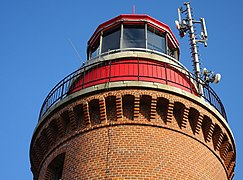Bastorf lighthouse
| Beacon Buk | ||
|---|---|---|
| Bastorf lighthouse | ||
| Place: | Bastorf | |
| Location: | on the Mecklenburg Bay | |
| Geographical location: | 54 ° 7 '55 " N , 11 ° 41' 37" E | |
| Height of tower base: | 78.8 m above sea level NHN | |
| Fire carrier height : | 20.8 | |
| Fire height : | 95.3 | |
|
|
||
| Identifier : |
LFl (4) WR. 45 s 2.1+ (6.9) +2.1+ (6.9) +2.1+ (6.9) +2.1+ (15.9) s |
|
| Scope knows: | 24 nm (44.4 km ) | |
| Scope red: | 20 nm (37 km ) | |
| Optics: | Twenty-sided rotating lens apparatus with 16 headlight lenses | |
| Operating mode: | electric, 400 W metal halide lamp | |
| Function: | Orientation and warning lights | |
| Construction time: | 1876 to 1878 | |
| Operating time: | December 1878 to date | |
| International ordinal number: | C 1400 | |
The lighthouse of Bastorf is located in the municipality of Bastorf on the Mecklenburg Bay of the Baltic Sea above Cape Bukspitze, therefore (nautically correct) also called Buk . With a height of only 20.8 m, it is one of the smallest German lighthouses and has the international serial number C 1400 . In addition to its function as an orientation light on the western Baltic Sea, its main task is to warn of "Hannibal", a sandbank in the entrance to the Wismar Bay (warning light).
location
The tower stands at 78.8 m above sea level. NHN high Bastorfer Signalberg , the western marking point of the terminal moraine of the cooling . The tower , built in 1878 with a height of 95.3 m, is the highest beacon in a German lighthouse, even before the Dornbusch lighthouse on the island of Hiddensee (95 m). On German coasts, only the fire in the system on the Maritim-Hotel Travemünde is even higher at 114.7 meters.
history
It took 50 years from the first considerations to erect a lighthouse on the Bukspitze before the imperial government had the necessity examined in 1876. Construction began in the same year. In just 18 months, master builder Hansen from Kröpelin built the lighthouse Buk with workers from Brunshaupten according to plans by the master builder Carl Luckow . The red, round, white jointed tower originally had a dark cap. The complex also included two apartments for the lighthouse keepers. In 1924/25, the kerosene wick lighting was replaced by an electric light that shone from January 2, 1925. A reserve gas lighting provided automatic replacement in the event of a power failure.
Until the early 1960s, the tower was a popular destination. After that it was classified as a military object and could not be entered for several years. It was only after 1990 that the tower was opened to the public again as an observation tower.
In 1979, the last lighthouse keeper retired. The beacon technology now worked automatically and was under the GDR's sea hydrographic service until the political change .
The two-storey tower was renovated in several construction phases between 1991 and 1999. Facilities of the German Navy ( directional radio station ) and the social services of the Federal Transport Administration (four apartments for family recreation) also found their place. As with the adjoining guard's house, mostly bricks were used. The optics that were already in place when the fire went into operation in December 1878 is still fully operational. A MG hit by an Allied aircraft towards the end of World War II caused damage to six of the 20 glass fields of the Fresnel optics . Two of them could be repaired by reassembling the broken glass. As a result, the tower had the unusual identifier of 16 lightning bolts (Blz. (16)) for a few years after the war . Then the lens fields were regrouped and until today the fire shows four flashes every 45 seconds (Blk. (4)).
technology
The rotating lens system consists of 20 sectors, 16 of which are lenses with a focal length of 700 mm. The other four fields are covered. The rotation time is 180 seconds. A metal halide lamp of 400 watts with a light intensity of around 1.2 million candelas provides a 45-second flashing group (2.1 seconds shining, 6.9 seconds pause, repeated twice, then 2.1 seconds shining and 15.9 seconds Break).
photos
Philatelic appreciation
In a philatelic appraisal of the tower, Deutsche Post AG issued a postage stamp worth 45 euro cents on July 3, 2014 . The design of this stamp in the lighthouses stamp series, which has existed for 10 years, comes, like all 20 stamps in the series so far, by the graphic artist Professor Johannes Graf based on a photographic template by Reinhard Scheiblich .
Individual evidence
- ↑ Nachrichten für Seefahrer No. 4393/1924: ... is to receive an electric incandescent lamp at the beginning of December ... Mains connection ... If the ... electricity fails, liquid gas incandescent light burns. - W.-A. Rostock November 26th and RVM November 28th 1924






